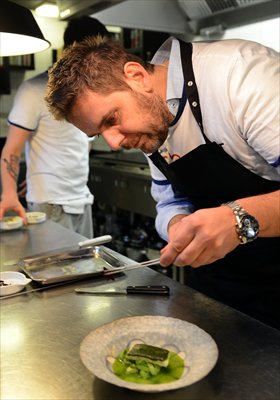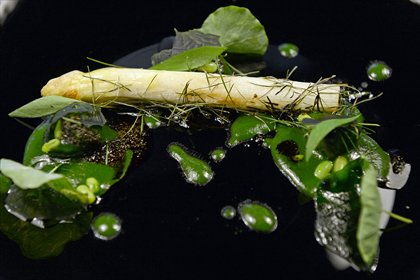Stories served up on a platter

World-famous chef Wojciech Modest Amaro prepares a dish at his restaurant Atelier Amaro in Warsaw in May. Photo: AFP

World-famous chef Wojciech Modest Amaro prepares a dish at his restaurant Atelier Amaro in Warsaw in May. Photo: AFP
Most people don't know there is a brief moment every year when hungry pike hunt the tiny, unsuspecting ducklings bobbing on the rivers and lakes of Poland.
But diners visiting the Atelier Amaro restaurant in the heart of Warsaw around that time can hear all about it from chef Wojciech Modest Amaro, as he serves up that brute of a fish sprinkled with drops of marinated baby duck blood.
The first chef in Polish history to receive a Michelin star likes to dish out what he calls "moments" of time and nature to his guests with his seasonal creations.
Since he opened his restaurant a year and half ago, Amaro has served over 100 different meals, each one available only when its ingredients can be harvested fresh from nature.
He also likes to deconstruct traditional Polish recipes and recreate them with the use of science and is building a laboratory a few streets away. Reuters talked to Amaro about food and his inspirations:
Q: What is the philosophy behind your cooking?
A: Our philosophy is mostly based on observations of nature and on attempts to redefine and recreate the Polish cuisine.
Chefs generally treat food seasonally. They split the year into four seasons. I find this strange. I mean look at this year. Can we even compare the first day of spring this year with last year?
So we split the year into 52 weeks and started to write down products available in nature in every one of those weeks. It turned out that the amount of possibilities is overwhelming. For example, in the 39th week of the year (late September), we had 538 products on our list. If that does not offer a base for creation, then I don't know what does. Especially since, on average, people use 12-15 products from supermarkets.
Q: Polish cuisine is seen as boring, fatty and potato-based. Most people abroad think of perogies. Can this change?
A: I do feel that we have some kind of a pioneer role. We want to get rid of this stereotype that Polish food is about perogies and fried pork chops in batter, not to mention the Polish sausage. We have an abundance of fresh and tasty and high quality food and since 60 percent of success is ingredients, we can build a high standard cuisine.
Many chefs who have visited us have drawn inspirations from us. I think that the awareness abroad of what the Polish cuisine is all about is growing at the speed of light.
Q: So why is Polish cuisine making its move today?
A: Over the last 20 years, since the transformation from communism, Poles have satisfied their basic desires, like an apartment or a car, symbols of the West. And now it's time for different aspirations.
Poland's cuisine will be making its mark in the world in the next few years, there is already more and more talk about what the Polish cuisine is all about. The day will come when people around the world will be saying: Let's have Polish tonight.
Q: What else are you doing to help improve Polish culinary reputation?
A: I want to spread the word. But to do that I will need to open more restaurants. I just came back from New York. So maybe New York?
Q: What do you cook your children for breakfast?
A: Roasted lin seeds with apples, bananas, cardamom and cinnamon.
Q: Are you saying your kids never make you go to McDonald's?
A: They do. With some things you don't get much choice.
Q: Do you cook at home a lot as well?
A: Yes, my wife doesn't like to cook. At least I don't have to grocery shop. I just take products from the restaurant.
Deer, sunflower seeds and foie gras (serves 4 people)
200g loin of deer
75g foie gras
100g sunflower seeds
100g caraway seeds
250ml grape seed oil
300g simple syrup
5g Dijon mustard
1g moss essence
200ml sunflower oil
Sea salt flakes
1. Pour grape seed oil into a food processor which also cooks food at the same time, add caraway seeds, set temperature to 70 degrees Celsius and blend at full speed for 12 minutes. Pour into a tall glass jar and leave for 8 hours before decanting.
2. Strain to get just clear oil infused with caraway.
3. Pour simple syrup and moss essence into a saucepan. Add sunflower seeds and bring to boil. Strain and chill the seeds and syrup.
4. Repeat the process of boiling and chilling twice again, then deep fry the seeds in batches in sunflower oil at 190 degrees Celsius.
5. Drain on paper towel and season with sea salt.
6. Cut the deer meat into cubes deep freeze it and then puree the frozen meat it into a mousse, using a high-speed food-processor. The recipe recommends using a Pacojet. Chill in the fridge.
7. Put foie gras in the freezer, so it is completely frozen.
8. Before serving, take the mousse out of the fridge, put in a bowl, add 2 tablespoons of caraway oil, season with sea salt and mustard. Mix well and place portions on the plates.
9. Take foie gras out of the freezer and grate using a microplane grater over the mousse.
Be generous so the foie gras covers all of the deer meat.
10. Season with sea salt and serve immediately.